176 Search Results for prompt
October 3, 2013
by Carole Zangari -
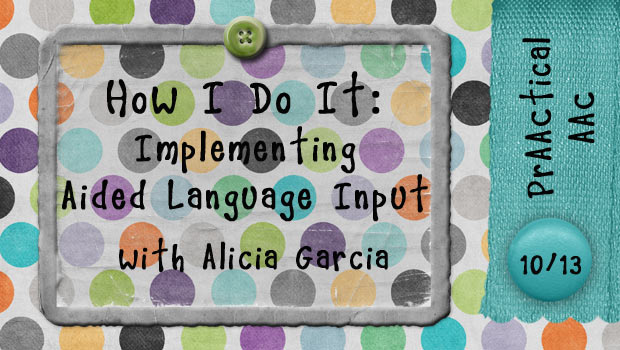
We are so pleased to have reconnected with SLP Alicia Garcia and are even more delighted that she agreed to do a guest post. Alicia is the clinical lead of the AAC Clinic at One Kids Place, a children’s treatment centre in northern Ontario. She has over 20 years of experience in pediatric rehabilitation practice in private and public settings, including clinical practice in AAC clinics and programs in Wisconsin, Florida, and now in Ontario. In this post, Alicia addresses one of our favorite clinical strategies in a very prAACtical way. Implementing Aided Language Stimulation: 8 Frequent Mistakes and How to Avoid Them Aided Language seems like a simple concept: Partners should model or demonstrate picture communication when talking to children who are learning to use picture communication, so that they would learn by example. Yet, when it comes to implementation we see frequent mistakes and misinterpretations. The most commons being:... [Read More...]
August 23, 2013
by Robin Parker -
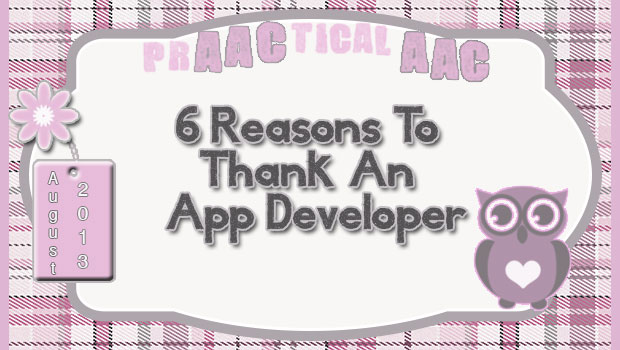
As you know, we love combining apps in intervention as one tool for engaging learners in meaningful language activities. Apps can also be used within home prAACtice and ‘waiting time’ recommendations. Some of the apps we use and recommend are made for general as well as special education while others are just everyday apps developed to make life easier. When we use the apps for communication and language there are some features that help many of our students. Additionally, there are updates and other things that really help educators. This is just a beginning list of app features we love (feel free to write with more). THANKYOU APP DEVELOPERS FOR: Listening to feedback- we have emailed many app developers with ‘feedback’ and have always received responses and often that feedback is incorporated into updates to the app. Building in choice making opportunities- We love apps that require active participation on the part... [Read More...]
August 22, 2013
by Carole Zangari -
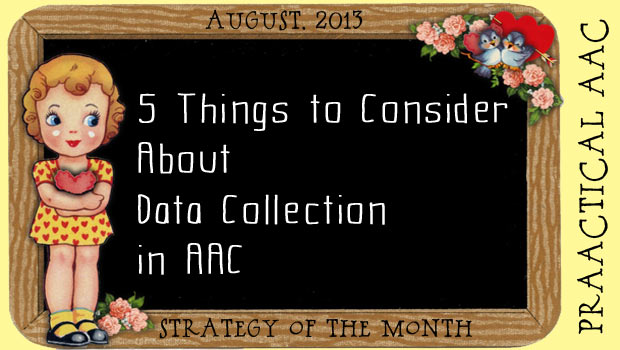
As a rule, SLPs are pretty good about collecting data in their clinical work. Here are some of our prAACtical thoughts about data collection. 1. Don’t bite off more than you can chew. We’ve visited several programs where the client data filled a huge 3-ring binder. In some places, they logged the data daily, reviewed it frequently, and actually USED it to make programmatic decisions. If that works for you, great! But most programs only reviewed the data when they had to report it or prior to a visit by someone who might want to see and discuss those data. In those cases, the data really wasn’t serving it’s original purpose: to see how instruction might need to be tweaked for a client who was learning quickly, slowly, or not at all. The takeaway: Don’t collect more data than you’re prepared to review and put to use. 2. We should... [Read More...]
August 20, 2013
by Robin Parker -
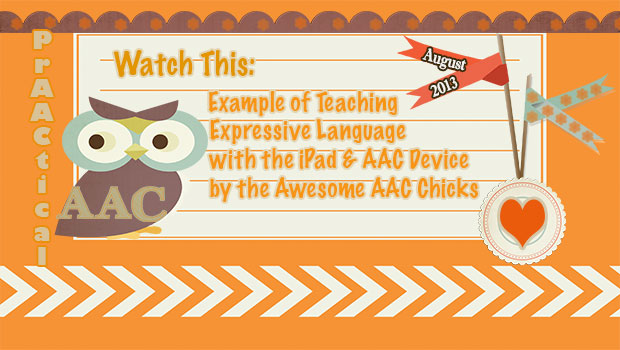
Here is authentic AAC teaching by the AAC Chicks. Watch for the combined use of AAC language facilitation strategies. Can you see: aided language input, wait & signal/time delay prompt, specific reinforcement, expansions, scaffolding, modeling, and more. Also, for the SLP’s, notice the data collection that does not distract from the session.
July 27, 2013
by Carole Zangari -
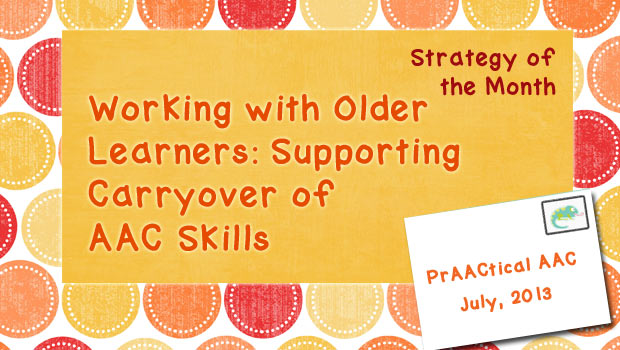
One of the biggest challenges that SLPs face is how to help the communicator use new skills outside the therapy room. Whether the client is someone who stutters, has voice problems, or any other speech-language difficulty, the question is the same: How can we get the client to use skills that were learned and practiced in a therapeutic situation to use those same skills at home, in school, and in the community? It’s an issue with all learners, but for adolescents and adults, we seem to be playing ‘catch up’ all the time. Plus, they are encountering greater numbers of less familiar communication partners and have to fend for themselves more often, making skill generalization even more of a critical topic. Much has been written about problems of generalization by using loose training, and varying the instructional setting, partners, instructions, prompts, and materials. In our way of thinking, it starts... [Read More...]
July 19, 2013
by Robin Parker -
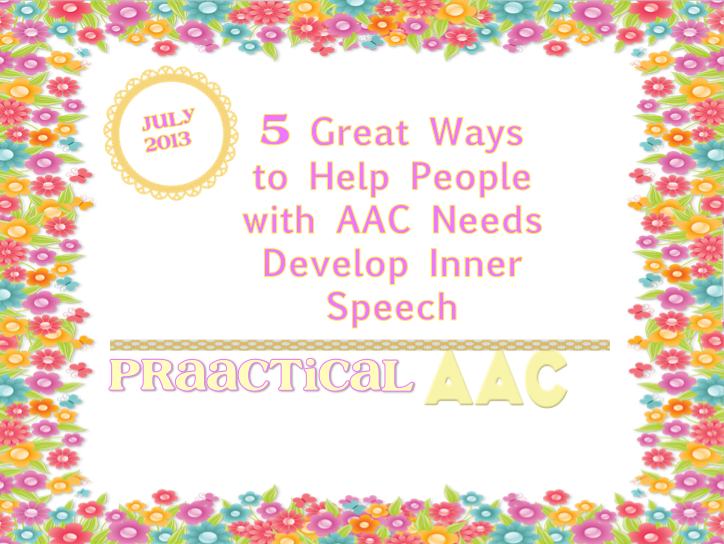
Inner speech is important. Recent research has strengthened our belief that developing inner speech is an important strategy for many people who use AAC and are working to build their literacy, sensory, and language skills. But how do we teach someone to develop that inner voice? Here are some ideas. 1. Begin by using a ‘think aloud’ strategy to make your internal thought processes obvious to the person who uses AAC. Articulating your thoughts as you work through different communication and literacy learning processes gives the learner insight into what you are thinking. Once they are used to that, it is easier to introduce the concept of private/inner speech. – 2. Use explicit instruction. “Say it to yourself.” “Say it in your head.” Using natural gestures, like tapping your temple, can be helpful as well. We’ve found that this allows us to reduce the prompting over time. Fade the verbal prompt and... [Read More...]
July 6, 2013
by Carole Zangari -
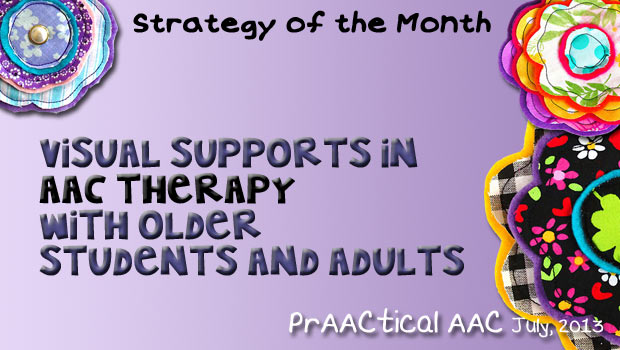
When learners are still struggling with communication in their teenage years and beyond, it means we have a lot of catching up to do. There are lots of implications for us as SLPs, of course, but the main one is this: Every interaction should have a purpose. As we head to the waiting room or classroom to see this student, we’re focused on how we can elicit practice on meaningful skills in the next few minutes. On a good day, we can use these few minutes before the session productively. Before we get to the therapy room we try to: use expectant pauses and graduated prompting to elicit a greeting at his/her highest level engage him/her in conversation to practice social exchanges provide opportunities for him/her to respond to a non-obligatory communicative context and facilitate a response make basic requests, like asking for help to open the door that we’ve... [Read More...]
June 29, 2013
by Carole Zangari -
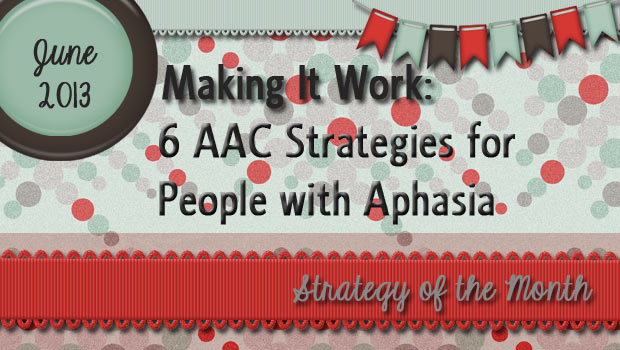
People with aphasia are often most successful when a number of different strategies are combined. In this post, we discuss a number of strategies that we can use in our therapy and teach to communication partners. Augmented Input We’ve written so many posts about aided language input that we’re almost embarrassed to bring it up again. Almost. It seems like no matter which age group or clinical population is the subject of our post, that strategy plays a central role. It is the same for people with aphasia with one exception. They benefit from a broader array of input cues, such as gestures, writing, and even pantomime. Augmented input is the term that is used to refer to oral language that is supplemented with pictures, print, gestures, pantomime, and the use of objects in the environment. By using these things as you speak, you enhance the ability of the person... [Read More...]
June 4, 2013
by Carole Zangari -
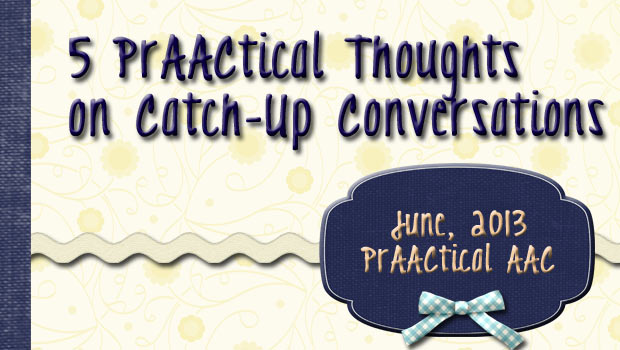
One of the things SLPs frequently do at the start of their therapy sessions is have some casual conversations with their clients to catch up on what happened since their last visit. Whether it is an elementary school student with ASD, a teenager with cerebral palsy, or an older adult with aphasia, we engage in polite conversation to find out what they’ve been up to and perhaps share a bit about our own experiences. Here are some thoughts on making those ‘catch-up conversations’ work from a prAACtical perspective. 1. Possible goal areas: initiate conversation; maintain dialogue on an established topic; redirect conversation to a new topic; respond to non-obligatory communication opportunities; use temporal terms in multi-word utterances; convey a personal narrative with a clear beginning, middle, and end; use regular past tense verbs; ask partner-focused questions 2. Core language targets: it, we, they, do/did, have/had, was/were, not It was (not);... [Read More...]
May 13, 2013
by Carole Zangari -
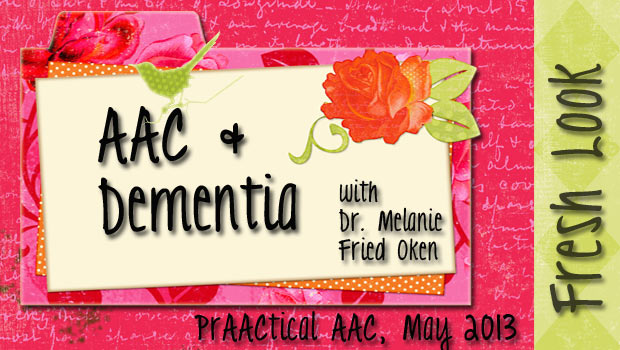
We’re thrilled to continue our Fresh Look series in celebration of Better Hearing and Speech Month (#BHSM). In this post, Dr. Melanie Fried Oken, from the Oregon Health and Science University, talks about some AAC strategies for people with dementia. I was captivated by her 2012 presentation on this topic at ISAAC 2012, and knew it was important to be able to share some of you work with you. We have much to offer these individuals with dementia, and Melanie’s post and linked resources are a great way to get started. ::::::::::::::::::::::::::::::::::::::::::::::::: Hey, what about us AAC providers who work with adults? We love reading PrAACtical AAC and can often adjust the tips, equipment recommendations, and strategies to meet our population needs. So when Carole gave me an opportunity to blog about AAC for adults with dementia, I grabbed the chance. I’d like to share with you some facts about... [Read More...]









